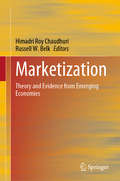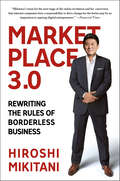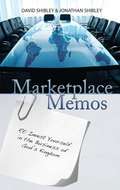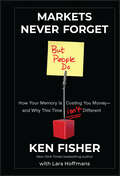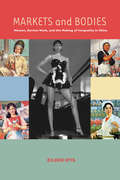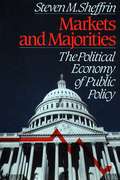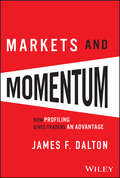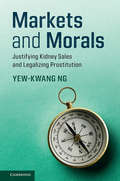- Table View
- List View
Marketization: Theory and Evidence from Emerging Economies
by Russell W. Belk Himadri Roy ChaudhuriThis book critically examines marketization: a phenomenon by which market processes are institutionalized and marketing increasingly pervades all areas of our everyday life. It presents a number of theories, frameworks and empirical studies highlighting how the phenomenon of marketization affects the 21st century consumer. The book also contests the traditional understanding of markets, offering a more comprehensive treatment of marketization and a fresh perspective on the dynamics of markets and the institutions that control everyday consumption practices.This book is an ideal resource for academics, reflective practitioners and policy-makers interested in formulating appropriate change strategies in the face of the globalization that affects emerging markets so profoundly. This well-crafted research book is a valuable addition to the sparse literature on theories of marketization. The authors refigure the existing theories more broadly and present compelling evidence and insights into market phenomenon such as marginality, alternative market forms and consumer identity.
Marketplace 3.0: Rewriting the Rules of Borderless Business
by Hiroshi MikitaniThe CEO behind Rakuten and Kobo reveals how his unique approach to empowerment and collaboration defies conventional wisdom, and isthe future of growth and globalization strategy.If Web 2.0 described the shift from static to interactive life on the Web, then 3.0 is the next sea change — driven by personalization, intelligent search, and user behavior. And that evolution has huge implications for everything we see, buy and do online. Rejecting the zero-sum, vending-machine model of ecommerce practiced by other leading internet retailers, who view the Internet purely as a facilitator of speed and profit, Hiroshi Mikitani argues for an alternate model that benefits merchants, consumers, and communities alike by empowering players at every step in the process. He envisions retail "ecosystems," where small and mid-sized brick-and-mortar businesses around the world partner with online marketplaces to maximize their customer bases and service capabilities, and he shows why emphasizing collaboration over competition, customization over top-down control, and long-term growth over short-term revenue is by far the best use of the Internet's power, and will define the 3.0 era. Rakuten has already pioneered this new model, and Marketplace 3.0 offers colorful examples of its success in Japan and around the world. Mikitani reveals how the company enforces a global mindset (including the requirement that all its employees speak English, even in Tokyo); how it incorporates new acquisitions rather than seeking to completely remake or sell them for a quick profit; and how it competes with other retailers on speed and quality, without sacrificing the public good. Marketplace 3.0 is an exciting new vision for global commerce, from a company that's challenging all the accepted wisdom.
Marketplace Dignity: Transforming How We Engage with Customers Across Their Journey
by Cait Lamberton Neela A. Saldanha Tom WeinEverywhere we turn, brands and organizations are under fire for failing to treat their customers with respect and dignity. And increasingly, consumers want firms to take a lead in helping to shape a better society. Yet, most don’t know where to start or have struggled to get things right.In Marketplace Dignity, Cait Lamberton, Neela A. Saldanha, and Tom Wein introduce a tangible, practical way to take a stand on the fundamental value of humans, and in so doing, be a force for good in a society that increasingly demands that they do so. Marketplace dignity is the idea that customers seek respect and recognition from the firms they interact with, not just rational or emotional benefits. Marketplace dignity appeals to humans’ sense of justice and goes to the essence of what makes customers human. It is also a powerful driver of their engagement, loyalty, and satisfaction.In this book, you will discover how to:+ Apply the principles of marketplace dignity to the whole of the customer journey, from the pre-consumption phase to the post-consumption phase;+ Design and deliver products, services, and experiences that respect your customers’ dignity and value as human beings;+ Improve your performance using the Marketplace Dignity Framework, which is underpinned by representation, agency, and equality; and+ Create a competitive edge and a positive social impact with marketplace dignity.Drawing on the authors’ rigorous research, as well as the successes and failures of companies around the world, from Fortune 100 companies to nonprofits to independent organizations, Marketplace Dignity will empower you to diagnose, understand, and enhance the way that you engage with your customer base across the entirety of their journey with your organization.
Marketplace Lending, Financial Analysis, and the Future of Credit
by Ioannis Akkizidis Manuel StagarsThe time for financial technology innovation is now Marketplace Lending, Financial Analysis, and the Future of Credit clearly explains why financial credit institutions need to further innovate within the financial technology arena. Through this text, you access a framework for applying innovative strategies in credit services. Provided and supported by financial institutions and entrepreneurs, the information in this engaging book encompasses printed guidance and digital ancillaries. Furthermore, the comprehensive text offers interviews with leaders in the field of fintech and financial technology innovation. Peer-to-peer lenders are steadily growing within the financial market. Integrating peer-to-peer lending into established credit institutions could strengthen the financial sector as a whole, and could lead to the incorporation of stronger risk and profitability management strategies. Explain (or Explore) approaches and challenges in financial analysis applied to credit risk and profitability Explore additional information provided via digital ancillaries, which will further support your understanding and application of key concepts Navigate the information organised into three subject areas: describing a new business model, knowledge integration, and proposing a new model for the Hybrid Financial Sector Understand how the rise of fintech fits into context within the current financial system Follow discussion of the current status quo and role of innovation in the financial industry, and consider the financial technology innovation landscape from the perspective of an entrepreneur Marketplace Lending, Financial Analysis, and the Future of Credit is a critical text that bridges the gap in understanding between financial technology entrepreneurs and credit institutions.
Marketplace Lifestyles in an Age of Social Media: Theory And Methods
by Lynn R Kahle Pierre Valette-FlorenceThis book approaches the concept of lifestyle from a contemporary scholarly perspective, and subjects it to rigorous theoretical and conceptual standards from an integrated, applied psychological point of view. Marketplace Lifestyles in an Age of Social Media is exceptionally current, demonstrating how recent trends and developments in social media reflect the importance of lifestyle research in marketing. Numerous examples, illustrations, and comprehensive references are provided, making this volume the best single resource for scholars, students, and marketing experts in this important area of marketing theory and practice.
Marketplace Memos
by David Shibley Jonathan ShibleyAre you searching for deeper meaning in your life and your work? Learn to live beyond the bottom line! Marketplace Memosis a powerful collection of devotionals specifically geared towards the business community. Finding fulfillment in life and work coincides with our alignment with God?s Kingdom purposes in the marketplace. Topics include: Harnessing Your Competitive Advantage, Healthy Partnerships, Rich Advice, Doing Business by Revelation, and more! Be personally invested in the business of His Kingdom. Unleash your talent, treasures and opportunities to maximize your impact in the marketplace.
Markets And Civil Society
by Victor Pa©rez-DaazThe nature of the currently emerging European society, which includes the economic and social transformation of Eastern and Central European countries, has been hotly debated. At its center is the relationship between markets and civil society within political and social contexts. The contributors to this volume offer perspectives from various disciplines (the social sciences, conceptual history, law, economics) and from several European countries in order to explore the ways in which markets influence various forms of civil society, such as individual freedom, social cohesion, economic effectiveness and democratic governance, and influence the construction of a civil society in a broader sense.
Markets And Civil Society
by Victor Pérez-DíazThe nature of the currently emerging European society, which includes the economic and social transformation of Eastern and Central European countries, has been hotly debated. At its center is the relationship between markets and civil society within political and social contexts. The contributors to this volume offer perspectives from various disciplines (the social sciences, conceptual history, law, economics) and from several European countries in order to explore the ways in which markets influence various forms of civil society, such as individual freedom, social cohesion, economic effectiveness and democratic governance, and influence the construction of a civil society in a broader sense.
Markets Never Forget (But People Do): How Your Memory Is Costing You Money-and Why This Time Isn't Different
by Kenneth L. Fisher Lara HoffmansSir John Templeton, legendary investor, was famous for saying, "The four most dangerous words in investing are, 'This time it's different.'" He knew that though history doesn't repeat, not exactly, history is an excellent guide for investors. In Markets Never Forget But People Do: How Your Memory Is Costing You Money and Why This Time Isn't Different, long-time Forbes columnist, CEO of Fisher Investments, and 4-time New York Times bestselling author Ken Fisher shows how and why investors' memories fail them--and how costly that can be. More important, he shows steps investors can take to begin reducing errors they repeatedly make. The past is never indicative of the future, but history can be one powerful guide in shaping forward looking expectations. Readers can learn how to see the world more clearly--and learn to make fewer errors--by understanding just a bit of investing past.
Markets Over Mao
by Nicholas R. LardyPeterson Institute for International Economics; Institute for International Economics; IIE; PIIE; 978-0-88132-693-2; 978-0-88132-694-9; Nicholas R. Lardy; Nicholas Lardy; Nick Lardy; Markets over Mao; The Rise of Private Business in China; markets, market economy, China, Chinese economy; China's growth; Chinese private firms; economic growth; global trader; China private sector; state firms; foreign direct investment; GDP of China; Chinese imports; Chinese exports; rural reforms; rural credit cooperatives; growth; investments; state-owned firms; state-owned enterprises; state capitalism; urban cooperative banks; urban production; wage flexibility; village enterprises
Markets Over Mao: The Rise of Private Business in China
by Nicholas LardyChina's transition to a market economy has propelled its remarkable economic growth since the late 1970s. In this book, Nicholas R. Lardy, one of the world's foremost experts on the Chinese economy, traces the increasing role of market forces and refutes the widely advanced argument that Chinese economic progress rests on the government's control of the economy's "commanding heights." In another challenge to conventional wisdom, Lardy finds little evidence that the decade of the leadership of former President Hu Jintao and Premier Wen Jiabao (2003–13) dramatically increased the role and importance of state-owned firms, as many people argue. This book offers powerfully persuasive evidence that the major sources of China's growth in the future will be similarly market rather than state-driven, with private firms providing the major source of economic growth, the sole source of job creation, and the major contributor to China's still growing role as a global trader. Lardy does, however, call on China to deregulate and increase competition in those portions of the economy where state firms remain protected, especially in energy and finance.
Markets and Bodies
by Eileen M. OtisInsulated from the dust, noise, and crowds churning outside, China's luxury hotels are staging areas for the new economic and political landscape of the country. These hotels, along with other emerging service businesses, offer an important, new source of employment for millions of workers, but also bring to light levels of inequality that surpass most developed nations. Examining how gender enables the globalization of markets and how emerging forms of service labor are changing women's social status in China, Markets and Bodies reveals the forms of social inequality produced by shifts in the economy. No longer working for the common good as defined by the socialist state, service workers are catering to the individual desires of consumers. This economic transition ultimately affords a unique opportunity to investigate the possibilities and current limits for better working conditions for the young women who are enabling the development of capitalism in China.
Markets and Cultural Voices
by Tyler CowenThis intriguing work explores the world of three amate artists. A native tradition, all of their painting is done in Mexico, yet, the finished product is sold almost exclusively to wealthy American art buyers. Cowen examines this cultural interaction between Mexico and the United States to see how globalization shapes the lives and the work of the artists and their families. The story of these three artists reveals that this exchange simultaneously creates economic opportunities for the artists, but has detrimental effects on the village. A view of the daily village life of three artists connected to the larger art world, this book should be of particular interest to those in the fields of cultural economics, Latino studies, economic anthropology and globalization.
Markets and Growth in Early Modern Europe (Perspectives in Economic and Social History #20)
by Victoria N BatemanThis is the first study to analyze a wide spread of price data to determine whether market development led to economic growth in the early modern period.
Markets and Justice: Nomos XXXI (NOMOS - American Society for Political and Legal Philosophy #5)
by John W. Chapman J. Roland PennockIn this thirty-first annual volume in the American Society of Legal and Political Philosophy's NOMOS series, entitled Markets and Justice, a number of distinguished authors consider a variety of topics in the area where economics, philosophy, and political science join paths. Included are essays such as "Contractarian Method, Private Property, and the Market Economy," "Justice Under Capitalism," and "Market Choice and Human Choice." Authors include Joshua Cohen, MIT; Gerald F. Gaus, University of Queensland; Margaret Jane Radin, University of Southern California; and Andrzej Rapaczynski, Columbia University.Part of a well-known and important series, Markets and Justice will prove invaluable to political scientists, legal scholars, philosophers, and their students.Part of a well-known and important series, Markets and Justice will prove invaluable to political scientists, legal scholars, philosophers, and their students.
Markets and Justice: Nomos XXXI (NOMOS - American Society for Political and Legal Philosophy #5)
by John W. Chapman J. Roland PennockIn this thirty-first annual volume in the American Society of Legal and Political Philosophy's NOMOS series, entitled Markets and Justice, a number of distinguished authors consider a variety of topics in the area where economics, philosophy, and political science join paths. Included are essays such as "Contractarian Method, Private Property, and the Market Economy," "Justice Under Capitalism," and "Market Choice and Human Choice." Authors include Joshua Cohen, MIT; Gerald F. Gaus, University of Queensland; Margaret Jane Radin, University of Southern California; and Andrzej Rapaczynski, Columbia University.
Markets and Majorities
by Steven M. SheffrinAmerica's government intervenes in almost every aspect of its citizens' daily lives. From the air we breathe, to our health, wealth, and security, Americans wade through a vast political ocean. Unfortunately, we do so blindly; few Americans understand how or why our government regulates the market mechanisms that surround us. In Markets and Majorities, Steven Sheffrin addresses essential yet overlooked questions about political intervention in economic spheres. Why should we trust the government to clean our air? How do we know what to define as clean? What kind of health insurance business will the government run? What are the dangers of publicly financed doctors? Sheffrin first explains traditional theories of market failure, used to justify intervention. He then combines the crucial question of political viability with the fascinating particulars of policy histories. Sheffrin applies such analysis to the areas of health care, social security, environmental policy, product liability, trade policy, and fiscal and budgetary policy. He argues that beneath each area lies a unique calculus of market failure and political pressures, and convincingly demonstrates that no single policy can be understood out of economic and political context. In short, the fact that markets may fail does not guarantee that politics will succeed. By examining both sides of each policy area, Sheffrin's careful review of our national policy-making reveals a minefield where, in many cases, politics cannot help but fail as badly as markets. However, he shows that all is not lost, citing, among other examples, political intervention in the medical industry as the only hope of stopping hospitals from competitive purchases of useless technology. Markets and Majorities is must reading for anyone who has ever wondered why government just can't seem to get things done, as well as anyone who has asked why it should try in the first place.
Markets and Market Places in Medieval Italy c. 1100 to c. 1440
by Dennis RomanoCathedrals and civic palaces stand to this day as symbols of the dynamism and creativity of the city-states that flourished in Italy during the Middle Ages. Markets and Marketplaces in Medieval Italy argues that the bustling yet impermanent sites of markets played an equally significant role, not only in the economic life of the Italian communes, but in their political, social, and cultural life as well. Drawing on a range of evidence from cities and towns across northern and central Italy, Dennis Romano explores the significance of the marketplace as the symbolic embodiment of the common good; its regulation and organization; the ethics of economic exchange; and how governments and guilds sought to promote market values. With a special focus on the spatial, architectural, and artistic elements of the marketplace, Romano adds new dimensions to our understanding of the evolution of the market economy and the origins of commercial capitalism and Renaissance individualism.
Markets and Measurements in Nineteenth-Century Britain
by Aashish VelkarMeasurements are a central institutional component of markets and economic exchange. By the nineteenth century, the measurement system in Britain was desperately in need of revision: a multiplicity of measurement standards, proliferation of local or regional weights and measures, and a confusing array of measurement practices made everyday measurements unreliable. Aashish Velkar uncovers how metrology and economic logic alone failed to make 'measurements' reliable, and discusses the importance of localised practices in shaping trust in them. Markets and Measurements in Nineteenth-Century Britain steers away from the traditional explanations of measurement reliability based on the standardisation and centralisation of metrology; the focus is on changing measurement practices in local economic contexts. Detailed case studies from the industrial revolution suggest that such practices were path-dependent and 'anthropocentric'. Therefore, whilst standardised metrology may have improved precision, it was localised practices that determined the reliability and trustworthiness of measurements in economic contexts.
Markets and Momentum: How Profiling Gives Traders an Advantage
by James F. Dalton Robert B. DaltonElevate your trading strategy with actionable market insights from an industry pioneer In Markets & Momentum: How Profiling Gives Traders an Advantage, James F. Dalton and co-author Robert B. Dalton dramatically expand on their revolutionary first book, Markets in Profile. Summarizing a lifetime of experience—from formative memberships on the CBOE and CBOT to his role as UBS Director of Hedge Fund Research—Jim challenges traders to recognize that market-understanding must be balanced with self-understanding. Jim’s deep market savvy is complimented by Rob’s engaging prose that adds a wealth of insight about the powerful influence of unexamined emotions, impulses, and habits on your trading success. Jim promotes trader education through Jim Dalton Trading (jimdaltontrading.com), along with his partners Jennifer Loh and Raghu Rajput, driven by the knowledge that the only reliable, objective, actionable information is market-generated. This information is scientifically organized via the Market Profile, which is simply a contextual organization of time, price, and volume—the core components of any financial transaction. Markets & Momentum offers: Deep dives into issues that lead more than 90% of day traders to lose money, including fading trend days, FOMO, doubling down on losing trades, and failing to let profits run. Strategies for minimizing the influence of news hype and analysis overload in order to remain focused on the only information that matters. Techniques for understanding your own emotional and intuitive reactions, and learning to avoid making impulsive decisions. This book is ideal for day and short-term traders, and for longer-term investors seeking to improve trade entries and exits. Jim Dalton’s trading insights are supported by six decades of learning directly from the markets, as well as from his wide base of educational clients. Markets & Momentum is a must-read for traders looking for guidance on developing the insights and skills necessary for conquering the short-term market.
Markets and Morals: Justifying Kidney Sales and Legalizing Prostitution
by Yew-Kwang NgConsidering efficiency, equality, and morality, this book argues for qualified market expansion, particularly in legalizing kidney sales and prostitution. Legalizing prostitution will benefit both men and women, as argued in a chapter jointly written with Yan Wang. Blood donation without monetary compensation can still result in adequate blood supply if schools educate children that blood donation can actually benefit a donor's health. As a society becomes more advanced, with higher incomes and a better educated populace, more activities can be subject to market exchange, with gradual popular acceptance. Without serious misinformation and irrationality, inequality/fairness as such cannot be a valid reason for limiting the scope of the market. The book supports the use of markets to increase efficiency while also increasing the effort to promote equality, making all income groups better off.
Markets and Policy Measures in the Evolution of Electric Mobility
by Dirk Fornahl Michael HülsmannThis edited monograph collects theoretical, empirical and political contributions from different fields, focusing on the commercial launch of electric mobility, and intending to shed more light on the complexity of supply and demand. It is an ongoing discussion, both in the public as well as in academia, whether or not electric mobility is capable of gaining a considerable market share in the near future. The target audience primarily comprises researchers and practitioners in the field, but the book may also be beneficial for graduate students.
Markets and Politics in Central Asia (Economies In Transition To The Market Ser. #Vol. 2)
by Gregory GleasonOver a decade after national independence, it is apparent that the contrasting development strategies adopted by the five new governments of Central Asia have led to significantly different outcomes. This well-written and timely book analyses how the development strategies of these countries have affected their transition from communist governance.
Markets and Power: The 21st Century Command Economy
by Eric A. SchutzIn what ways do the actions and economic behavior of today's multinational corporations resemble the functioning and processes of the old command economics of the Soviet Union? By ignoring questions about power relations in markets, mainstream neoclassically-oriented economists conclude that there are no significant power structures operating in market systems to control allocation and distribution. This book argues to the contrary that there are fundamental and systemic power structures - monopoly, access to information or finance, employer power, etc. - at work in market economies, which affects their ability to achieve real "competition" in much the same way as state-controlled, command economies hinder business activities. Thus, for example, the biggest firms at the hubs of financial "networks" wield a kind of "shaping power" upon large numbers of relatively autonomous firms, not only upon those that belong to the networks but also on the many firms outside them that are also affected.
Markets and Rural Poverty: Upgrading in Value Chains
by Jonathan Mitchell Christopher ColesThis book explores the place of poor people within a rich variety of value chains, focusing upon lagging, rural regions in Africa and Asia, and how they can 'upgrade' within such chains. Upgrading is a key concept for value chain analysis and refers to the acquisition of technological capabilities and market linkages that enable firms to improve their competitiveness and move into higher-value activities. The authors examine a range of evidence to assess whether the 'bottom billion' people, living mainly in the rural areas of low-income countries, can improve their position through productive strategies and, if so, how? They propose an innovative conceptual framework of value chain upgrading for some of the most marginal producers in the poorest local economies. They demonstrate how interventions can improve poverty and the environment for poor people supplying a wide range of services and agricultural and food products to local, regional and global markets. This analysis is based on empirical research conducted in Senegal, Mali, Tanzania, India, Nepal, Philippines and Vietnam. The main focus is on poverty, environment and gender outcomes of upgrading interventions, and represents one of the key challenges of contemporary development economics.
